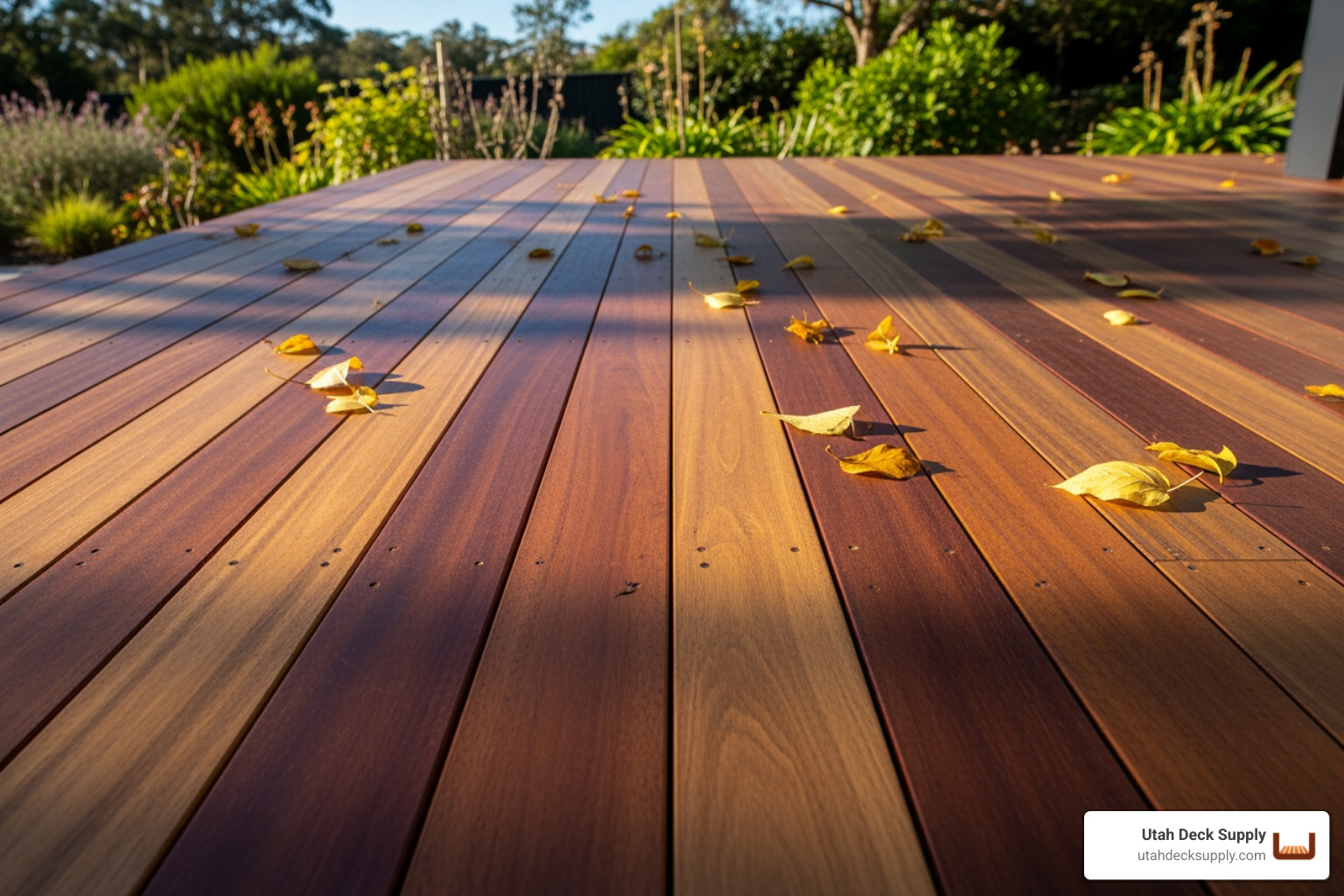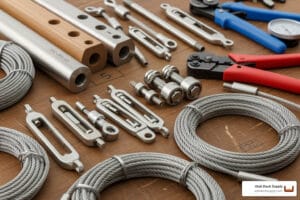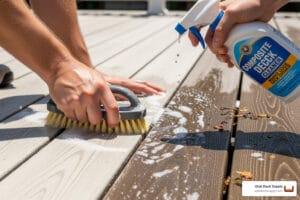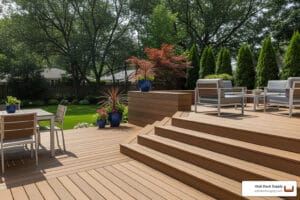A beautiful timber deck can transform your backyard into a stunning outdoor oasis, perfect for relaxing with family and creating lasting memories. But before you can build your dream deck, you need to find the right materials from a reliable source. This guide will walk you through everything you need to know to find the best timber decking suppliers in your area, ensuring your project is a success from the ground up.
Why Choosing the Right Timber Decking Supplier Matters
Timber decking suppliers near me are more than just places to pick up boards—they’re your partners in creating an outdoor space that lasts. Whether you’re a seasoned contractor running multiple jobs across the Wasatch Front or a homeowner tackling your first DIY deck project, finding a supplier with the right inventory, expertise, and service can make or break your timeline and budget. The global timber decking market was valued at USD 11.5 billion in 2022 and is projected to reach USD 17.8 billion by 2030, reflecting growing demand for quality outdoor living materials.
Quick Answer: What to Look for in Local Timber Decking Suppliers
When searching for timber decking suppliers near you, prioritize these key factors:
- Product Selection – Wide range of wood species (pressure-treated pine, cedar, redwood, tropical hardwoods like Ipe)
- Quality & Certifications – FSC or PEFC sustainably sourced lumber, proper grading, and treatment options
- Expert Guidance – Knowledgeable staff who understand span charts, climate challenges, and code requirements
- Services – Delivery, custom cutting, design advice, and installer recommendations
- Inventory Levels – Consistent stock of premium materials year-round, not just seasonal availability
- Pricing Transparency – Clear per-linear-foot pricing, contractor discounts, and volume pricing options
Where to Start Your Search
- Specialized Deck Supply Stores – Often carry premium brands and offer expert technical support
- Local Lumber Yards – Traditional option with general building materials and some decking inventory
- Big-Box Retailers – Convenient but may lack specialized expertise and consistent stock
- Online Locators – Brand websites like Trex and TimberTech help you find authorized dealers nearby
The difference between a good supplier and a great one often comes down to technical expertise and problem-solving ability. As one satisfied customer noted about a specialized decking supplier: “I found they had everything I needed for my deck project with unbeatable prices and their customer service is top-notch.”
My Experience in the Decking Industry
I’m James Bonham, co-founder of Utah Deck Supply, and I spent years working at Trex Company before launching Utah’s premier specialized decking superstore in 2023. During that time, I saw how frustrating it is for contractors and homeowners to find reliable timber decking suppliers near me who truly understand the unique demands of building in extreme climates—which is exactly why we created a one-stop resource focused on expert guidance, premium inventory, and real solutions for Utah’s outdoor living projects. My goal is to help you steer the supplier landscape and find a partner who will support your project from design through installation.
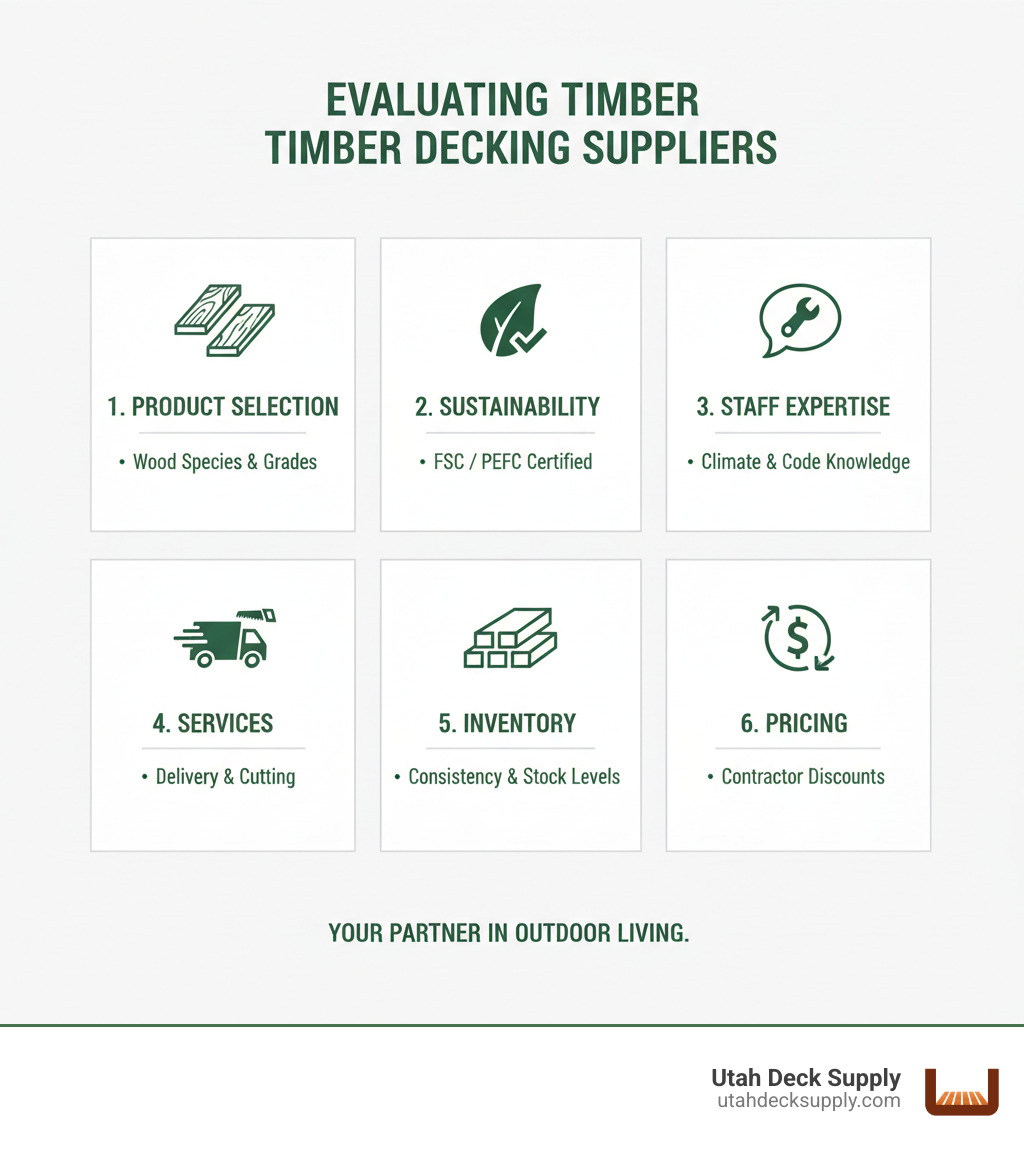
The supplier you choose directly impacts your project’s success, timeline, and long-term durability. A great timber decking supplier doesn’t just hand you materials—they help you avoid costly mistakes, source the right species for your climate, and keep your project moving forward when challenges arise.
Poor supplier choices lead to common frustrations:
- Running out of materials mid-project because inventory wasn’t available
- Finding mismatched board colors when you need additional pieces months later
- Getting stuck with inferior grades that warp or split within the first season
- Wasting time driving between multiple stores to find specialized fasteners or hardware
- Receiving zero technical support when you hit installation questions about joist spacing or code compliance
The right supplier becomes your project partner:
They stock premium materials year-round, understand local building codes and climate challenges (like Utah’s brutal freeze-thaw cycles and high UV exposure), and have staff who can answer technical questions on the spot. They can track down discontinued colors for warranty repairs, suggest upgrades that increase your project’s value, and deliver materials directly to your jobsite when you need them.
For contractors especially, supplier reliability translates directly to profitability. Every hour spent hunting for materials or dealing with inferior products is an hour not spent building, and every callback for warped boards eats into your margins. Homeowners benefit too—the right guidance upfront means your deck will look beautiful and perform flawlessly for decades, not just seasons.
Understanding Your Timber Decking Options
Before you start calling around to timber decking suppliers near me, you need to understand what you’re actually asking for. Not all wood is created equal, and choosing the right species for your deck makes the difference between a beautiful outdoor space that lasts decades and a maintenance nightmare that warps within a few seasons. The good news is that once you understand the basics of wood types, grades, and treatments, you’ll be able to walk into any supplier with confidence and ask the right questions.
For a comprehensive look at wood selection custom to your specific needs, check out our guide: The Ultimate Guide to Choosing the Best Wood for Your Deck.
Common Wood Species for Decking
When you’re shopping for timber decking, you’ll encounter two main categories: softwoods and hardwoods. In Utah’s climate—where we face intense UV exposure, dramatic temperature swings, and those brutal freeze-thaw cycles—durability and weather resistance aren’t optional features, they’re essential.
Pressure-treated pine is the workhorse of the decking world and the most budget-friendly option you’ll find. Typically Southern Yellow Pine, it’s chemically treated under high pressure with copper-based preservatives like Copper Azole (CA), Alkaline Copper Quat (ACQ), or Micronized Copper Azole (MCA). These treatments protect against rot, fungal decay, and termite attacks. While the upfront cost is attractive, pressure-treated pine demands regular maintenance—annual cleaning and periodic sealing—to prevent swelling, cracking, splitting, and warping. Standing water is pine’s worst enemy, so proper drainage is critical. For structural stability, you’ll need supports every 16 inches on center for standard 5/4 x 6 boards.
Cedar, particularly Western Red Cedar, brings natural beauty to the table with its warm reddish-brown tones and pleasant aroma. Its natural oils provide built-in resistance to moisture, decay, and insects without any chemical treatment. Cedar is lighter than most hardwoods, making it easier to handle during installation, and you can expect a lifespan of 15 to 20 years with proper care. To maintain that gorgeous color and protect against moisture absorption, plan on applying a clear finish every few years.
Redwood shares many of cedar’s advantages—natural oils, insect resistance, rich color—with even greater stability and a slightly longer lifespan of around 20 years. If your deck will be close to or touching soil, invest in heartwood grades like Clear All Heart or Heart B for maximum durability. Like cedar, redwood benefits from regular cleaning and a clear protective finish to preserve its beauty and prevent moisture damage. For more insights on this premium option, explore the Benefits of Redwood Decking for Your Home.
Tropical hardwoods represent the top tier of timber decking, offering exceptional density, durability, and lifespans stretching from 25 to 50 years. Species like Ipe (Brazilian Walnut), Massaranduba (Brazilian Redwood), Cumaru (Brazilian Teak), Garapa (Brazilian Ash), and Tigerwood naturally resist mold, mildew, insects, and even fire. Their incredible density makes them phenomenally strong—perfect for high-traffic areas—and they resist shrinking and expanding far better than softwoods. The trade-off? You’ll need to pre-drill every fastener hole due to their hardness, ensure excellent ventilation around and beneath the boards, and seal any cut ends with an oily wax sealant. If you want to maintain their original rich colors rather than letting them age to a silvery gray, plan on applying oil finishes periodically. For the ultimate in longevity and performance, check out our guide on Best Lumber for Durable Decks.
Treated vs. Untreated Timber: What’s the Difference?
Understanding the distinction between treated and untreated timber helps you make informed decisions about your deck’s longevity and maintenance requirements.
Treated timber—primarily pressure-treated softwoods like pine—goes through an intensive process where chemical preservatives are forced deep into the wood fibers under extreme pressure. This dramatically improves rot resistance and insect resistance, making otherwise vulnerable wood suitable for outdoor exposure. Modern treatments are considered safe for residential use, though you should always wear gloves when handling the material and avoid inhaling sawdust during cutting. Even with treatment, these woods still require regular maintenance to look their best and maximize their lifespan. Proper staining and finishing not only improve appearance but also add an extra layer of protection—learn more in our guide to Deck Staining and Finishing: Enhancing Beauty and Durability.
Untreated timber includes naturally durable species like cedar, redwood, and tropical hardwoods. These woods possess natural durability thanks to their unique cellular structure and natural oils, which provide inherent resistance to decay and insects without any chemical intervention. While they don’t need pressure treatment, they’re not maintenance-free—regular cleaning and periodic sealing protect against UV damage and moisture absorption, which can lead to color fading or minor surface checking (small cracks). The advantage is you’re working with wood in its natural state, free from chemical treatments.
Lifespan and Maintenance for Different Timbers
Your deck is an investment, and understanding what each timber type demands in terms of care helps you choose the right material for your lifestyle and budget. Here’s what you can expect:
Pressure-treated pine typically lasts 15 to 25 years with diligent maintenance. You’ll need to clean it annually to remove dirt, mildew, and organic debris that can trap moisture. Every two to three years, plan on staining and sealing to protect the wood and maintain its appearance. Over time, you may need to refinish high-traffic areas more frequently. The typical cost ranges from $2 to $5 per linear foot, making it the most economical choice upfront—though the ongoing maintenance adds up over the years.
Cedar delivers 15 to 20 years of service with moderate maintenance requirements. Annual cleaning keeps it looking fresh, and you’ll want to apply a protective finish every few years to preserve that beautiful natural color and prevent moisture damage. Cedar typically costs between $4 and $8 per linear foot, positioning it as a mid-range option that balances natural beauty with reasonable durability.
Redwood offers a similar 20-year lifespan with comparable maintenance needs to cedar—annual cleaning and periodic refinishing to protect against the elements. The cost runs slightly higher, usually $6 to $12 per linear foot, reflecting its superior stability and rich, warm appearance that many homeowners find worth the premium.
Tropical hardwoods are the marathon runners of the decking world, lasting anywhere from 25 to 50 years with minimal maintenance. Annual cleaning is typically sufficient, and if you’re comfortable with the natural silvery-gray patina that develops over time, you can skip refinishing entirely. If you prefer to maintain the original rich tones, occasional oil treatments will do the job. These premium woods command premium prices—typically $8 to $15+ per linear foot—but when you factor in their exceptional longevity and low maintenance demands, they often prove cost-effective over the deck’s lifetime.
For comprehensive guidance on keeping your deck in peak condition regardless of which timber you choose, dive into The Ultimate Guide to Deck Maintenance.
When you’re ready to discuss these options with timber decking suppliers near me, you’ll be equipped to ask informed questions about wood grades, moisture content, proper storage, and which species perform best in Utah’s challenging climate. A knowledgeable supplier will appreciate your preparation and can offer even more detailed guidance custom to your specific project.

